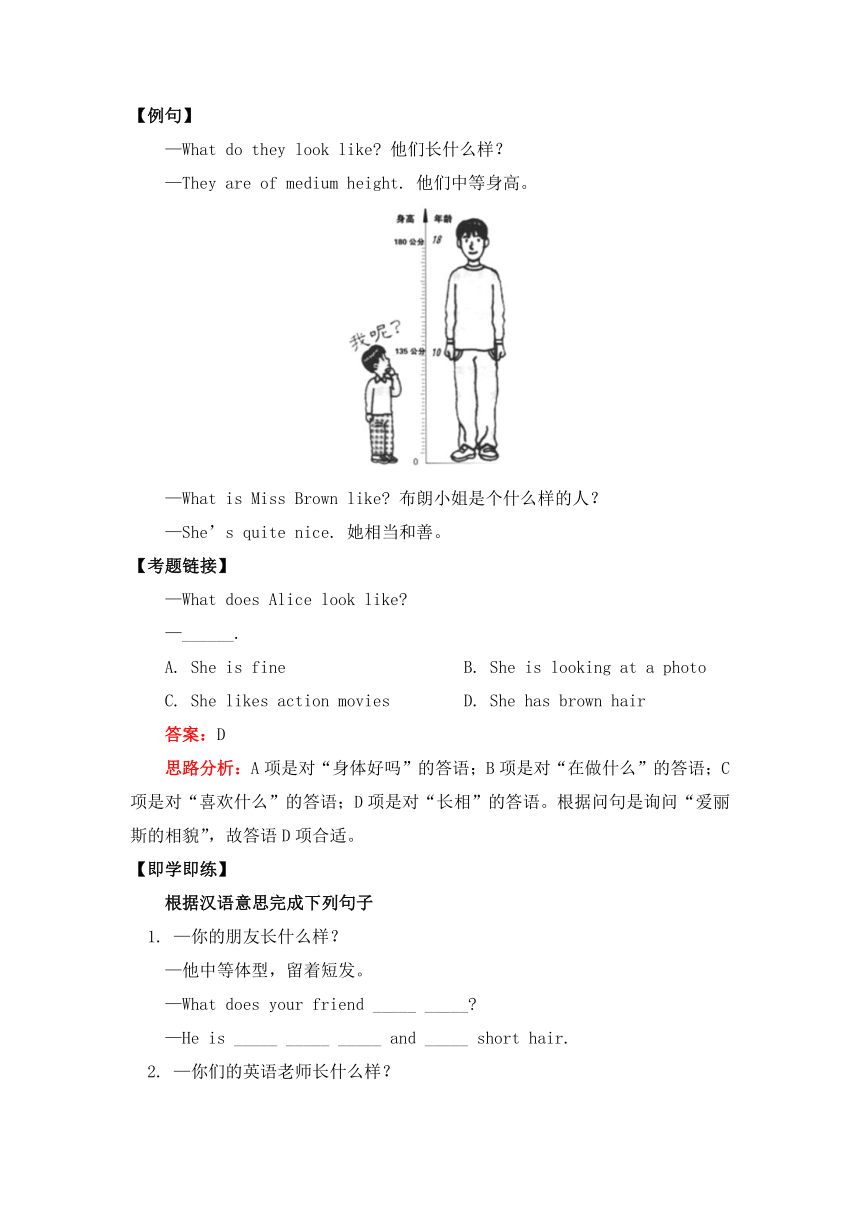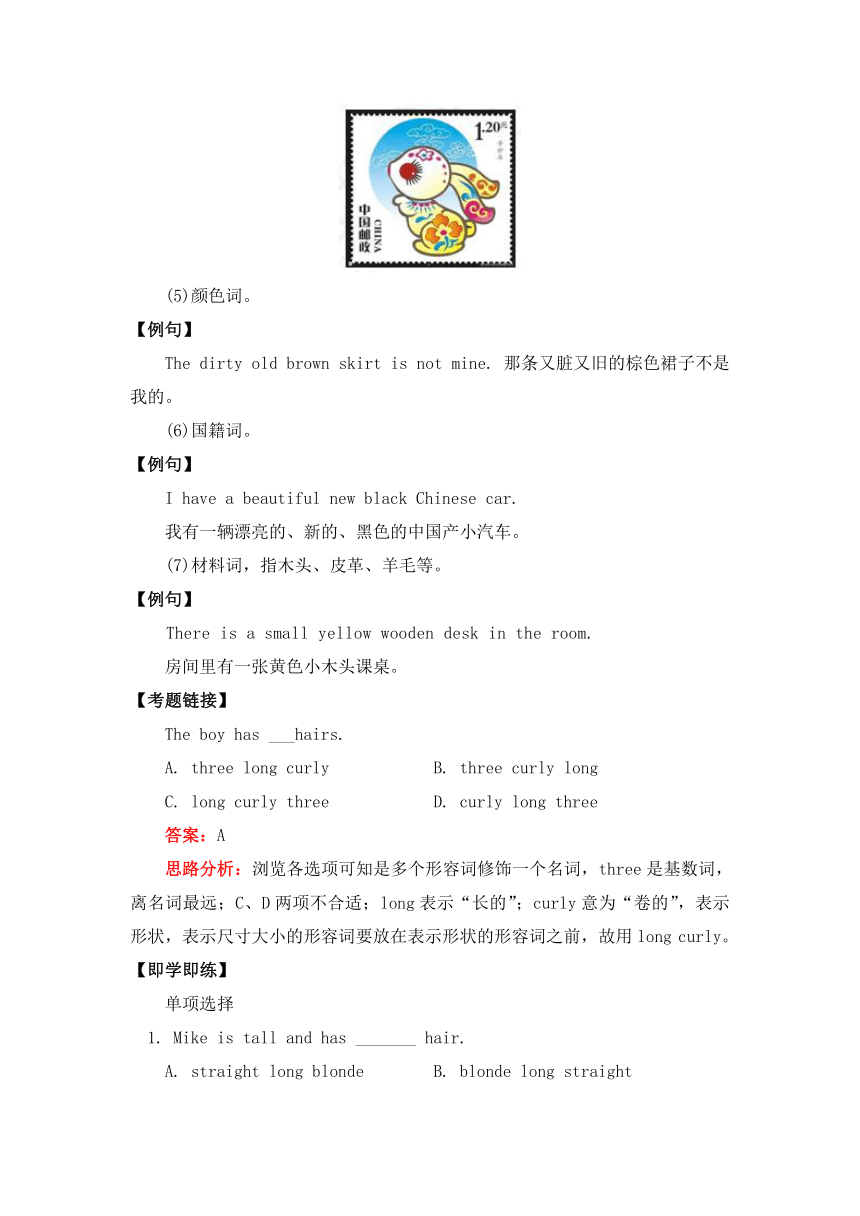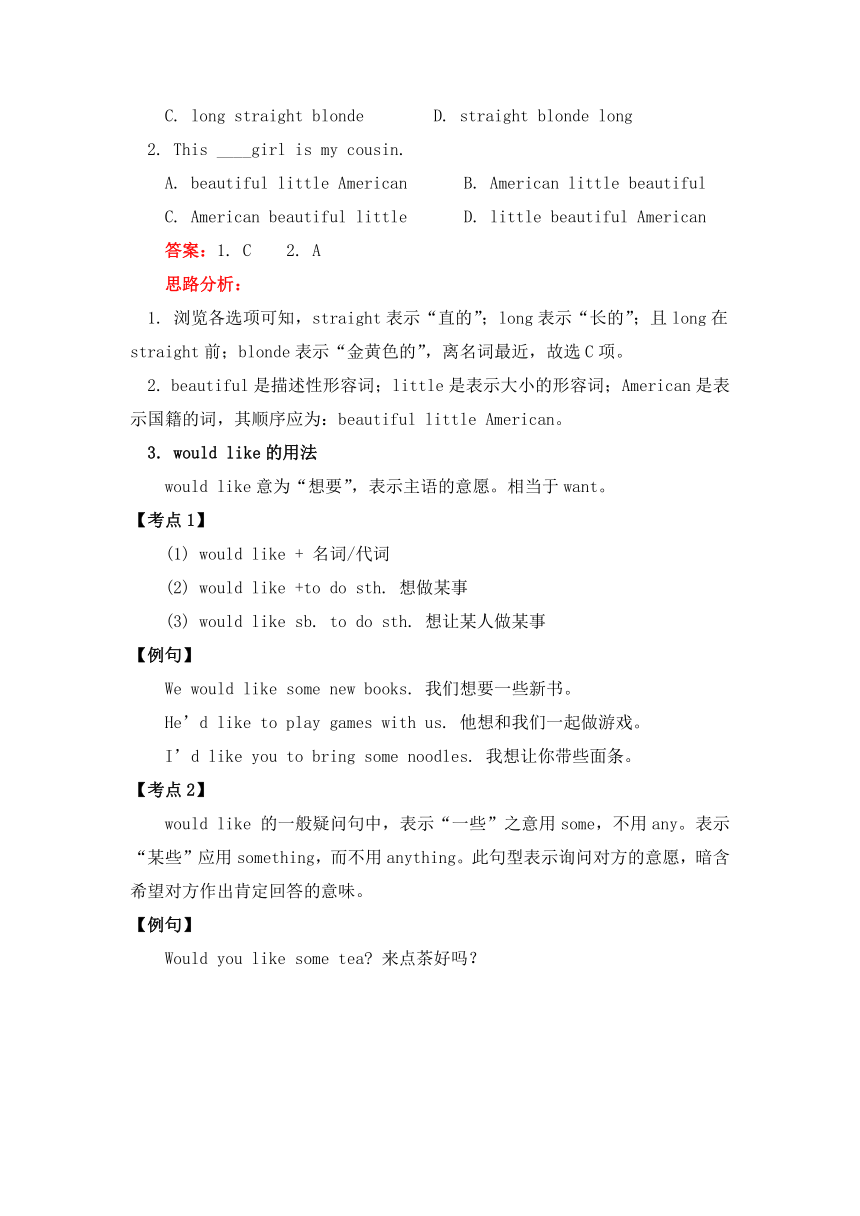英语七年级上册Units 1-2 语法归纳-导学案-鲁教版(五四学制)
文档属性
| 名称 | 英语七年级上册Units 1-2 语法归纳-导学案-鲁教版(五四学制) |  | |
| 格式 | doc | ||
| 文件大小 | 159.5KB | ||
| 资源类型 | 教案 | ||
| 版本资源 | 鲁教版 | ||
| 科目 | 英语 | ||
| 更新时间 | 2020-09-30 21:59:46 | ||
图片预览





文档简介
年 级 七年级 学 科 英语 版 本 鲁教版(五四学制)
课程标题 Units 1-2 语法归纳
一、学习目标
1. what引导的特殊疑问句询问某人的外貌
2. 多个形容词修饰同一个名词时的顺序
3. would like的用法
4. 可数名词和不可数名词再现
二、重点、难点
would like的用法
知识梳理:
【语法学习】
1. what引导的特殊疑问句询问某人的外貌
【考点1】
询问某人外貌的句型:
(1) What+ do/ does +某人(主语) +look like? 侧重于询问人的长相或总体特征。
(2) What + is + 某人(主语) +like? 侧重于询问某人的性格、气质、个性等内在的东西。
【考点2】
描述人物的外貌的句型:
(1) 主语+be+形容词/介词短语.
(2) 主语+have/ has +a/an+形容词+名词.
【例句】
—What do they look like? 他们长什么样?
—They are of medium height. 他们中等身高。
—What is Miss Brown like? 布朗小姐是个什么样的人?
—She’s quite nice. 她相当和善。
【考题链接】
—What does Alice look like?
—______.
A. She is fine B. She is looking at a photo
C. She likes action movies D. She has brown hair
答案:D
思路分析:A项是对“身体好吗”的答语;B项是对“在做什么”的答语;C项是对“喜欢什么”的答语;D项是对“长相”的答语。根据问句是询问“爱丽斯的相貌”,故答语D项合适。
【即学即练】
根据汉语意思完成下列句子
1. —你的朋友长什么样?
—他中等体型,留着短发。
—What does your friend _____ _____?
—He is _____ _____ _____ and _____ short hair.
2. —你们的英语老师长什么样?
—她个子不高,大眼睛。
—What _____ your English teacher _____ like?
—She is _____ and _____ big eyes.
答案:
1. look like; of medium build; has 2. does; look; short; has
2. 多个形容词修饰同一个名词时的顺序
【考点】
多个形容词修饰同一个名词时的顺序为:县(限)官(观)行(形)令(龄)演(颜)国才(材)。
(1)限定词,指冠词、指示代词、形容词性物主代词、(先)序数词、(后)基数词等。
【例句】
Please look at the first two words. 请看一下开始的两个单词。
(2)外观词,指描绘性形容词(多表主观看法)。
【例句】
I like these beautiful balls. 我喜欢这些漂亮的球。
(3)形状词,指大小、长短、高低、方圆等,且表尺寸大小的要放在表形状的之前。
【例句】
He is a brave young man. 他是一个勇敢的年轻人。
Can you see that small round table? 你看到那张小圆桌了吗?
(4)年龄词,指新、旧等。
【例句】
I have a beautiful new stamp. 我有一张漂亮的新邮票。
(5)颜色词。
【例句】
The dirty old brown skirt is not mine. 那条又脏又旧的棕色裙子不是我的。
(6)国籍词。
【例句】
I have a beautiful new black Chinese car.
我有一辆漂亮的、新的、黑色的中国产小汽车。
(7)材料词,指木头、皮革、羊毛等。
【例句】
There is a small yellow wooden desk in the room.
房间里有一张黄色小木头课桌。
【考题链接】
The boy has ___hairs.
A. three long curly B. three curly long
C. long curly three D. curly long three
答案:A
思路分析:浏览各选项可知是多个形容词修饰一个名词,three是基数词,离名词最远;C、D两项不合适;long表示“长的”;curly意为“卷的”,表示形状,表示尺寸大小的形容词要放在表示形状的形容词之前,故用long curly。
【即学即练】
单项选择
1. Mike is tall and has _______ hair.
A. straight long blonde B. blonde long straight
C. long straight blonde D. straight blonde long
2. This ____girl is my cousin.
A. beautiful little American B. American little beautiful
C. American beautiful little D. little beautiful American
答案:1. C 2. A
思路分析:
1. 浏览各选项可知,straight表示“直的”;long表示“长的”;且long在straight前;blonde表示“金黄色的”,离名词最近,故选C项。
2. beautiful是描述性形容词;little是表示大小的形容词;American是表示国籍的词,其顺序应为:beautiful little American。
3. would like的用法
would like意为“想要”,表示主语的意愿。相当于want。
【考点1】
(1) would like + 名词/代词
(2) would like +to do sth. 想做某事
(3) would like sb. to do sth. 想让某人做某事
【例句】
We would like some new books. 我们想要一些新书。
He’d like to play games with us. 他想和我们一起做游戏。
I’d like you to bring some noodles. 我想让你带些面条。
【考点2】
would like 的一般疑问句中,表示“一些”之意用some,不用any。表示“某些”应用something,而不用anything。此句型表示询问对方的意愿,暗含希望对方作出肯定回答的意味。
【例句】
Would you like some tea? 来点茶好吗?
Would you like something to drink? 你想来点喝的吗?
【考点3】
(1) Would you like +名词/ 代词? 的答语是:
Yes, please. / No, thanks.
(2) Would you like to do sth.? 的答语是:
Yes, I’d like/ love to.
I’d like to, but I …
【例句】
—Would you like some milk? 要点牛奶吗?
—Yes, please. / No, thanks. 好的,请来点。/ 不,谢谢。
—Would you like to go swimming? 你想去游泳吗?
—Yes, I’d love to. / I’d love to, but I must do my homework first.
是的,我想去。/ 我想去,但是我得先做家庭作业。
【考题链接】
1. —______?
—I’d like some noodles.
A. What do you like B. Do you like some noodles
C. What would you like D. What size would you like
答案:C
思路分析:根据答语“我想要一些面条”可知问句询问“你想要什么?”,故选C项。A项意为“你喜欢什么?”;B项意为“你喜欢面条吗?”;D项意为“你想要多大号的?”,均不符合题意。
2. —Would you like something to eat?
—______.
A. Yes, please B. No, I wouldn’t C. That’s right D. Yes, I would
答案:A
思路分析:对于“Would you like +名词/代词?”的肯定回答是:Yes, please. 故选A项。
3. Would you like _____ orange juice?
A. a B. an C. some D. any
答案:C
思路分析:orange juice是“橙汁”,不可数名词,不可用冠词修饰;本句表示询问对方的意愿,暗含希望对方作出肯定回答的意味,故用some。
【即学即练】
句型转换
1. Tom wants to have beef for lunch. (同义句)
Tom _____ _____ to have beef for lunch.
2. I’d like a small bowl of noodles. (改为一般疑问句)
_____ you _____ a small bowl of noodles?
3. I’d like to have some porridge and onions. (改为否定句)
I ______ _____ to have _____ porridge _____ onions.
4. —Would you like to come to my party? (作肯定回答)
—______, I’d _____ ______.
答案:
1. would like 2. Would; like 3. wouldn’t like; any; or 4. Yes; like/love to
4. 可数名词和不可数名词再现
可数名词有单、复数之分;而不可数名词没有单、复数之分。
【考点1】
可数名词复数形式的构成:
(1) 规则变化:
① 一般在词尾加-s。如:bananas。
② 以s, x, ch, sh 结尾的名词词尾加-es。如:watches,boxes, classes。
③ 以o 结尾的词,加-s或-es。如:photos, tomatoes。
初中阶段加-es的名词共有:英雄(heroes) 喜欢土豆(potatoes)和西红柿(tomatoes)。
④ 以辅音字母加y结尾的名词,把y变为i,再加-es。如:families。
而以元音字母加y结尾的名词,直接在词尾后加-s。如:boys。
⑤ 以f或fe结尾的名词,先变f或fe为v,再加-es。如:leaves, thieves。
(2) 不规则变化:
通过不规则变化变复数的名词,需要在学习的过程中一一掌握。
① man →men, woman →women, child →children, foot →feet, mouse →mice, tooth →teeth
② sheep(绵羊), Chinese, Japanese, fish 单复数同形。
③ 以man, woman作定语修饰名词的复合名词都变复数,而其它的只变最后一个。
a man teacher →men teachers, a woman worker →women workers
a bus driver→ three bus drivers
【注意】
(1) people、police等词的单数形式表示复数意义。
(2) 成对出现的名词常以复数形式呈现,如:shoes, socks, glasses, shorts, pants等。
【考点2】
不可数名词是无法直接用数目来计算的名词。
不可数名词不能用不定冠词修饰,也不存在复数形式,不能用基数词修饰,作主语时谓语动词用单数形式,可用much, some, any, lots of来修饰,表数量用“计量词+ of短语”。
【例句】
The rice is in the bowl. 米饭在碗里。
I don’t have any milk, but I have some tea. 我没有喝牛奶,但我喝了茶。
There are two pairs of glasses on the desk. 课桌上有两副眼镜。
【考题链接】
1. Would you like _____ fish _____ dinner?
A. one; to B. some; of C. some; for D. a; for
答案:C
思路分析:根据dinner“晚饭”可知fish表示“鱼肉”,是不可数名词,排除A, D两项;句意为“晚饭你想吃鱼吗?”,故C项正确。
2. He wants to buy some ______ and ______.
A. porridge; vegetable B. salad; tomatoes
C. potatos; bananas D. salad; orange juices
答案:B
思路分析:浏览各选项可知,C项的potatos错误,应为:potatoes;D项的orange juices错误,不可数名词没有复数形式;题干中的some后接不可数名词或可数名词复数,但A项中的vegetable是可数名词,没有变复数形式,错误。只有B项正确。
3. I’d like the hamburger with ______.
A. chicken B. a chicken C. chickens D. some chickens
答案:A
思路分析:chicken可作可数名词,意为“小鸡”,B项意为“一只小鸡”;C项是小鸡的复数形式;D项意为“一些小鸡”。chicken也可作不可数名词,意为“鸡肉”;句意为“我想要带鸡肉的汉堡包”,故A项合适。
【即学即练】
写出下列单词的复数形式
1. hamburger _______ 2. man doctor ______
3. noodle _______ 4. bowl _______
5. dumpling ________ 6. sheep _______
7. woman________ 8. child ________
9. potato________ 10. thief ________
答案:1. hamburgers 2. men doctors 3. noodles 4. bowls 5. dumplings
6. sheep 7. women 8. children 9. potatoes 10. thieves
课程标题 Units 1-2 语法归纳
一、学习目标
1. what引导的特殊疑问句询问某人的外貌
2. 多个形容词修饰同一个名词时的顺序
3. would like的用法
4. 可数名词和不可数名词再现
二、重点、难点
would like的用法
知识梳理:
【语法学习】
1. what引导的特殊疑问句询问某人的外貌
【考点1】
询问某人外貌的句型:
(1) What+ do/ does +某人(主语) +look like? 侧重于询问人的长相或总体特征。
(2) What + is + 某人(主语) +like? 侧重于询问某人的性格、气质、个性等内在的东西。
【考点2】
描述人物的外貌的句型:
(1) 主语+be+形容词/介词短语.
(2) 主语+have/ has +a/an+形容词+名词.
【例句】
—What do they look like? 他们长什么样?
—They are of medium height. 他们中等身高。
—What is Miss Brown like? 布朗小姐是个什么样的人?
—She’s quite nice. 她相当和善。
【考题链接】
—What does Alice look like?
—______.
A. She is fine B. She is looking at a photo
C. She likes action movies D. She has brown hair
答案:D
思路分析:A项是对“身体好吗”的答语;B项是对“在做什么”的答语;C项是对“喜欢什么”的答语;D项是对“长相”的答语。根据问句是询问“爱丽斯的相貌”,故答语D项合适。
【即学即练】
根据汉语意思完成下列句子
1. —你的朋友长什么样?
—他中等体型,留着短发。
—What does your friend _____ _____?
—He is _____ _____ _____ and _____ short hair.
2. —你们的英语老师长什么样?
—她个子不高,大眼睛。
—What _____ your English teacher _____ like?
—She is _____ and _____ big eyes.
答案:
1. look like; of medium build; has 2. does; look; short; has
2. 多个形容词修饰同一个名词时的顺序
【考点】
多个形容词修饰同一个名词时的顺序为:县(限)官(观)行(形)令(龄)演(颜)国才(材)。
(1)限定词,指冠词、指示代词、形容词性物主代词、(先)序数词、(后)基数词等。
【例句】
Please look at the first two words. 请看一下开始的两个单词。
(2)外观词,指描绘性形容词(多表主观看法)。
【例句】
I like these beautiful balls. 我喜欢这些漂亮的球。
(3)形状词,指大小、长短、高低、方圆等,且表尺寸大小的要放在表形状的之前。
【例句】
He is a brave young man. 他是一个勇敢的年轻人。
Can you see that small round table? 你看到那张小圆桌了吗?
(4)年龄词,指新、旧等。
【例句】
I have a beautiful new stamp. 我有一张漂亮的新邮票。
(5)颜色词。
【例句】
The dirty old brown skirt is not mine. 那条又脏又旧的棕色裙子不是我的。
(6)国籍词。
【例句】
I have a beautiful new black Chinese car.
我有一辆漂亮的、新的、黑色的中国产小汽车。
(7)材料词,指木头、皮革、羊毛等。
【例句】
There is a small yellow wooden desk in the room.
房间里有一张黄色小木头课桌。
【考题链接】
The boy has ___hairs.
A. three long curly B. three curly long
C. long curly three D. curly long three
答案:A
思路分析:浏览各选项可知是多个形容词修饰一个名词,three是基数词,离名词最远;C、D两项不合适;long表示“长的”;curly意为“卷的”,表示形状,表示尺寸大小的形容词要放在表示形状的形容词之前,故用long curly。
【即学即练】
单项选择
1. Mike is tall and has _______ hair.
A. straight long blonde B. blonde long straight
C. long straight blonde D. straight blonde long
2. This ____girl is my cousin.
A. beautiful little American B. American little beautiful
C. American beautiful little D. little beautiful American
答案:1. C 2. A
思路分析:
1. 浏览各选项可知,straight表示“直的”;long表示“长的”;且long在straight前;blonde表示“金黄色的”,离名词最近,故选C项。
2. beautiful是描述性形容词;little是表示大小的形容词;American是表示国籍的词,其顺序应为:beautiful little American。
3. would like的用法
would like意为“想要”,表示主语的意愿。相当于want。
【考点1】
(1) would like + 名词/代词
(2) would like +to do sth. 想做某事
(3) would like sb. to do sth. 想让某人做某事
【例句】
We would like some new books. 我们想要一些新书。
He’d like to play games with us. 他想和我们一起做游戏。
I’d like you to bring some noodles. 我想让你带些面条。
【考点2】
would like 的一般疑问句中,表示“一些”之意用some,不用any。表示“某些”应用something,而不用anything。此句型表示询问对方的意愿,暗含希望对方作出肯定回答的意味。
【例句】
Would you like some tea? 来点茶好吗?
Would you like something to drink? 你想来点喝的吗?
【考点3】
(1) Would you like +名词/ 代词? 的答语是:
Yes, please. / No, thanks.
(2) Would you like to do sth.? 的答语是:
Yes, I’d like/ love to.
I’d like to, but I …
【例句】
—Would you like some milk? 要点牛奶吗?
—Yes, please. / No, thanks. 好的,请来点。/ 不,谢谢。
—Would you like to go swimming? 你想去游泳吗?
—Yes, I’d love to. / I’d love to, but I must do my homework first.
是的,我想去。/ 我想去,但是我得先做家庭作业。
【考题链接】
1. —______?
—I’d like some noodles.
A. What do you like B. Do you like some noodles
C. What would you like D. What size would you like
答案:C
思路分析:根据答语“我想要一些面条”可知问句询问“你想要什么?”,故选C项。A项意为“你喜欢什么?”;B项意为“你喜欢面条吗?”;D项意为“你想要多大号的?”,均不符合题意。
2. —Would you like something to eat?
—______.
A. Yes, please B. No, I wouldn’t C. That’s right D. Yes, I would
答案:A
思路分析:对于“Would you like +名词/代词?”的肯定回答是:Yes, please. 故选A项。
3. Would you like _____ orange juice?
A. a B. an C. some D. any
答案:C
思路分析:orange juice是“橙汁”,不可数名词,不可用冠词修饰;本句表示询问对方的意愿,暗含希望对方作出肯定回答的意味,故用some。
【即学即练】
句型转换
1. Tom wants to have beef for lunch. (同义句)
Tom _____ _____ to have beef for lunch.
2. I’d like a small bowl of noodles. (改为一般疑问句)
_____ you _____ a small bowl of noodles?
3. I’d like to have some porridge and onions. (改为否定句)
I ______ _____ to have _____ porridge _____ onions.
4. —Would you like to come to my party? (作肯定回答)
—______, I’d _____ ______.
答案:
1. would like 2. Would; like 3. wouldn’t like; any; or 4. Yes; like/love to
4. 可数名词和不可数名词再现
可数名词有单、复数之分;而不可数名词没有单、复数之分。
【考点1】
可数名词复数形式的构成:
(1) 规则变化:
① 一般在词尾加-s。如:bananas。
② 以s, x, ch, sh 结尾的名词词尾加-es。如:watches,boxes, classes。
③ 以o 结尾的词,加-s或-es。如:photos, tomatoes。
初中阶段加-es的名词共有:英雄(heroes) 喜欢土豆(potatoes)和西红柿(tomatoes)。
④ 以辅音字母加y结尾的名词,把y变为i,再加-es。如:families。
而以元音字母加y结尾的名词,直接在词尾后加-s。如:boys。
⑤ 以f或fe结尾的名词,先变f或fe为v,再加-es。如:leaves, thieves。
(2) 不规则变化:
通过不规则变化变复数的名词,需要在学习的过程中一一掌握。
① man →men, woman →women, child →children, foot →feet, mouse →mice, tooth →teeth
② sheep(绵羊), Chinese, Japanese, fish 单复数同形。
③ 以man, woman作定语修饰名词的复合名词都变复数,而其它的只变最后一个。
a man teacher →men teachers, a woman worker →women workers
a bus driver→ three bus drivers
【注意】
(1) people、police等词的单数形式表示复数意义。
(2) 成对出现的名词常以复数形式呈现,如:shoes, socks, glasses, shorts, pants等。
【考点2】
不可数名词是无法直接用数目来计算的名词。
不可数名词不能用不定冠词修饰,也不存在复数形式,不能用基数词修饰,作主语时谓语动词用单数形式,可用much, some, any, lots of来修饰,表数量用“计量词+ of短语”。
【例句】
The rice is in the bowl. 米饭在碗里。
I don’t have any milk, but I have some tea. 我没有喝牛奶,但我喝了茶。
There are two pairs of glasses on the desk. 课桌上有两副眼镜。
【考题链接】
1. Would you like _____ fish _____ dinner?
A. one; to B. some; of C. some; for D. a; for
答案:C
思路分析:根据dinner“晚饭”可知fish表示“鱼肉”,是不可数名词,排除A, D两项;句意为“晚饭你想吃鱼吗?”,故C项正确。
2. He wants to buy some ______ and ______.
A. porridge; vegetable B. salad; tomatoes
C. potatos; bananas D. salad; orange juices
答案:B
思路分析:浏览各选项可知,C项的potatos错误,应为:potatoes;D项的orange juices错误,不可数名词没有复数形式;题干中的some后接不可数名词或可数名词复数,但A项中的vegetable是可数名词,没有变复数形式,错误。只有B项正确。
3. I’d like the hamburger with ______.
A. chicken B. a chicken C. chickens D. some chickens
答案:A
思路分析:chicken可作可数名词,意为“小鸡”,B项意为“一只小鸡”;C项是小鸡的复数形式;D项意为“一些小鸡”。chicken也可作不可数名词,意为“鸡肉”;句意为“我想要带鸡肉的汉堡包”,故A项合适。
【即学即练】
写出下列单词的复数形式
1. hamburger _______ 2. man doctor ______
3. noodle _______ 4. bowl _______
5. dumpling ________ 6. sheep _______
7. woman________ 8. child ________
9. potato________ 10. thief ________
答案:1. hamburgers 2. men doctors 3. noodles 4. bowls 5. dumplings
6. sheep 7. women 8. children 9. potatoes 10. thieves
同课章节目录
- Unit 1 What does he look like?
- Section A
- Section B
- Unit 2 I'd like some noodles.
- Section A
- Section B
- Unit 3 How was your school trip?
- Section A
- Section B
- Unit 4 What did you do last weekend?
- Section A
- Section B
- Unit 5 Where did you go on vacation?
- Section A
- Section B
- Unit 6 How often do you exercise?
- Section A
- Section B
- Unit 7 I'm more outgoing than my sister.
- Section A
- Section B
- Unit 8 What's the best movie theater?
- Section A
- Section B
